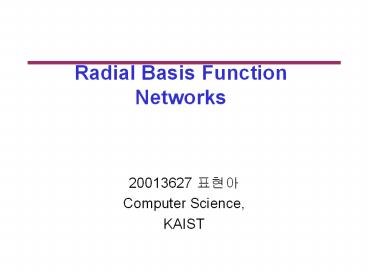Radial Basis Function Networks - PowerPoint PPT Presentation
1 / 25
Title:
Radial Basis Function Networks
Description:
supervised learning to estimate the linear weights of the output layer ... All free parameters of the network are changed by supervised learning process. ... – PowerPoint PPT presentation
Number of Views:170
Avg rating:3.0/5.0
Title: Radial Basis Function Networks
1
Radial Basis Function Networks
- 20013627 ???
- Computer Science,
- KAIST
2
contents
- Introduction
- Architecture
- Designing
- Learning strategies
- MLP vs RBFN
3
introduction
- Completely different approach by viewing the
design of a neural network as a curve-fitting
(approximation) problem in high-dimensional space
( I.e MLP )
4
In MLP
introduction
5
In RBFN
introduction
6
Radial Basis Function Network
introduction
- A kind of supervised neural networks
- Design of NN as curve-fitting problem
- Learning
- find surface in multidimensional space best fit
to training data - Generalization
- Use of this multidimensional surface to
interpolate the test data
7
Radial Basis Function Network
introduction
- Approximate function with linear combination of
Radial basis functions - F(x) S wi h(x)
- h(x) is mostly Gaussian function
8
architecture
h1
x1
W1
h2
x2
W2
h3
x3
W3
f(x)
Wm
hm
xn
Input layer
Hidden layer
Output layer
9
Three layers
architecture
- Input layer
- Source nodes that connect to the network to its
environment - Hidden layer
- Hidden units provide a set of basis function
- High dimensionality
- Output layer
- Linear combination of hidden functions
10
Radial basis function
architecture
m
f(x) ? wjhj(x)
j1
hj(x) exp( -(x-cj)2 / rj2 )
Where cj is center of a region, rj is width of
the receptive field
11
designing
- Require
- Selection of the radial basis function width
parameter - Number of radial basis neurons
12
Selection of the RBF width para.
designing
- Not required for an MLP
- smaller width
- alerting in untrained test data
- Larger width
- network of smaller size faster execution
13
Number of radial basis neurons
designing
- By designer
- Max of neurons number of input
- Min of neurons ( experimentally determined)
- More neurons
- More complex, but smaller tolerance
14
learning strategies
- Two levels of Learning
- Center and spread learning (or determination)
- Output layer Weights Learning
- Make ( parameters) small as possible
- Principles of Dimensionality
15
Various learning strategies
learning strategies
- how the centers of the radial-basis functions of
the network are specified. - Fixed centers selected at random
- Self-organized selection of centers
- Supervised selection of centers
16
Fixed centers selected at random(1)
learning strategies
- Fixed RBFs of the hidden units
- The locations of the centers may be chosen
randomly from the training data set. - We can use different values of centers and widths
for each radial basis function -gt experimentation
with training data is needed.
17
Fixed centers selected at random(2)
learning strategies
- Only output layer weight is need to be learned.
- Obtain the value of the output layer weight by
pseudo-inverse method - Main problem
- Require a large training set for a satisfactory
level of performance
18
Self-organized selection of centers(1)
learning strategies
- Hybrid learning
- self-organized learning to estimate the centers
of RBFs in hidden layer - supervised learning to estimate the linear
weights of the output layer - Self-organized learning of centers by means of
clustering. - Supervised learning of output weights by LMS
algorithm.
19
Self-organized selection of centers(2)
learning strategies
- k-means clustering
- Initialization
- Sampling
- Similarity matching
- Updating
- Continuation
20
Supervised selection of centers
learning strategies
- All free parameters of the network are changed by
supervised learning process. - Error-correction learning using LMS algorithm.
21
Learning formula
learning strategies
- Linear weights (output layer)
- Positions of centers (hidden layer)
- Spreads of centers (hidden layer)
22
MLP vs RBFN
23
Approximation
MLP vs RBFN
- MLP Global network
- All inputs cause an output
- RBF Local network
- Only inputs near a receptive field produce an
activation - Can give dont know output
24
in MLP
MLP vs RBFN
25
in RBFN
MLP vs RBFN




























